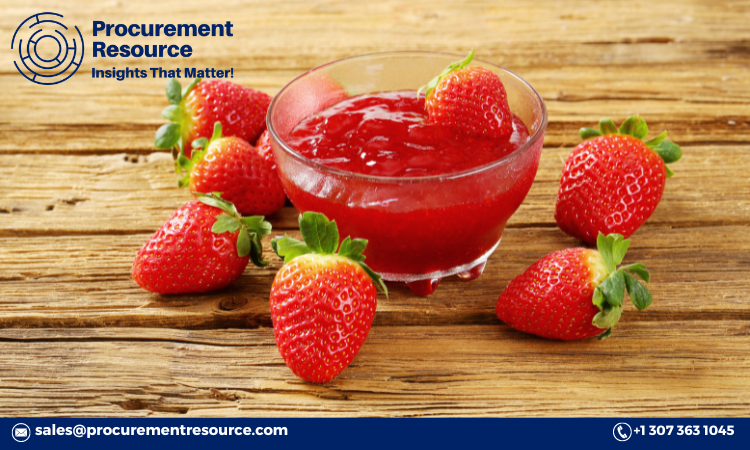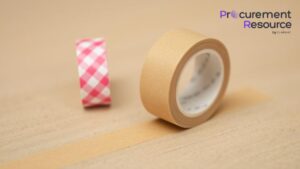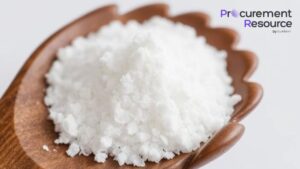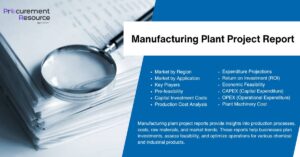
Strawberries, cherished for their vibrant color and juicy sweetness, are a popular fruit worldwide. The production of strawberry puree, a versatile product used in various culinary and industrial applications, requires a detailed understanding of the manufacturing process, raw material costs, and industry trends. This report aims to provide a comprehensive overview of the strawberry puree production process, including the latest news and developments in the industry.
Manufacturing Report and Process
The production of strawberry puree involves several crucial steps to ensure the final product is of high quality, safe for consumption, and retains the fruit’s natural flavors and nutrients. Here’s a step-by-step breakdown of the strawberry puree manufacturing process:
Request For Sample: https://www.procurementresource.com/production-cost-report-store/strawberry-puree/request-sample
- Harvesting and Selection: The process begins with the careful selection of ripe, high-quality strawberries. Harvesting is typically done manually to minimize damage to the fruits. Once harvested, the strawberries are sorted to remove any that are overripe, underripe, or damaged.
- Washing and Cleaning: The selected strawberries are thoroughly washed to remove dirt, pesticides, and any other contaminants. This step is essential to ensure the safety and quality of the final product. Advanced washing techniques, including the use of sanitizing agents, are employed to achieve optimal cleanliness.
- Hulling and Slicing: After washing, the strawberries are hulled to remove the green leafy tops. The hulling process can be done manually or with specialized machines. The hulled strawberries are then sliced to facilitate the pureeing process.
- Pureeing: The sliced strawberries are fed into a pureeing machine, where they are crushed and blended into a smooth, consistent puree. This machine often employs high-speed blades or rollers to achieve the desired texture. The pureeing process may involve heating the strawberries slightly to enhance the extraction of flavors and colors.
- Pasteurization: To ensure the puree is safe for consumption and has an extended shelf life, it undergoes pasteurization. This process involves heating the puree to a specific temperature for a set period to kill any harmful bacteria and microorganisms. Pasteurization also helps preserve the color and flavor of the puree.
- Packaging: The pasteurized strawberry puree is then packaged in sterilized containers to prevent contamination. Packaging options vary depending on the intended use and market, including glass jars, plastic bottles, and aseptic packaging for industrial applications. The packaging process is conducted in a controlled environment to maintain hygiene standards.
- Storage and Distribution: Once packaged, the strawberry puree is stored in a cool, dry place until it is ready for distribution. Proper storage conditions are crucial to maintaining the quality and shelf life of the product. The puree is then distributed to various markets, including retail, food service, and industrial sectors.
Raw Material Costs
The cost of raw materials is a significant factor in the production of strawberry puree. Several elements contribute to the overall raw material costs:
- Strawberries: The primary raw material, strawberries, accounts for the largest portion of the cost. The price of strawberries can vary based on factors such as seasonality, location, and agricultural practices. Organic strawberries may also command a higher price due to the stringent farming methods involved.
- Water: Water is essential for washing and processing the strawberries. The cost of water can fluctuate depending on the region and availability. In areas facing water scarcity, this cost can be substantial.
- Sanitizing Agents: Chemicals used for cleaning and sanitizing the strawberries add to the raw material costs. These agents are necessary to ensure the safety and quality of the final product.
- Packaging Materials: The cost of packaging materials, including jars, bottles, and aseptic containers, is another significant expense. High-quality packaging is crucial for maintaining the purity and shelf life of the strawberry puree.
- Energy: The energy required for running machinery, pasteurization, and maintaining storage conditions also contributes to the overall cost. Energy costs can vary based on the efficiency of the equipment used and local energy prices.
Latest News
The strawberry puree industry is continuously evolving, with advancements in technology, changing consumer preferences, and market dynamics shaping its future. Here are some of the latest news and trends in the industry:
- Technological Innovations: Innovations in processing equipment, such as more efficient pureeing machines and advanced pasteurization techniques, are improving the quality and efficiency of strawberry puree production. These technological advancements help manufacturers reduce waste, enhance product quality, and lower production costs.
- Sustainability Practices: With growing awareness of environmental issues, many producers are adopting sustainable practices. This includes sourcing strawberries from farms that use eco-friendly practices, reducing water usage, and utilizing recyclable packaging materials. Sustainability is becoming a key factor for consumers and manufacturers alike.
- Market Expansion: The demand for strawberry puree is expanding globally, driven by its versatile use in food products such as smoothies, desserts, and sauces. Emerging markets in Asia and Latin America are showing significant growth potential, providing new opportunities for producers.
- Health and Wellness Trends: As consumers become more health-conscious, there is an increasing demand for natural and organic strawberry puree. Producers are responding by offering products with minimal additives and preservatives, catering to the health and wellness trend.
- Impact of Climate Change: Climate change poses challenges to strawberry farming, affecting yields and quality. Unpredictable weather patterns and extreme temperatures can impact the supply and cost of strawberries. Producers are exploring ways to mitigate these effects through improved farming practices and resilient crop varieties.
Conclusion
The strawberry puree production process involves meticulous steps to ensure a high-quality product. From harvesting and cleaning to pureeing and packaging, each stage is crucial to maintaining the integrity and flavor of the strawberries. Raw material costs, driven primarily by the price of strawberries, play a significant role in the overall production cost. Keeping abreast of the latest news and trends, including technological advancements and sustainability practices, is essential for staying competitive in the evolving strawberry puree industry. As the demand for natural and healthy products continues to grow, the future of strawberry puree production looks promising, with opportunities for innovation and market expansion.



